Exploring Interior Wall Colors: A Comprehensive Guide
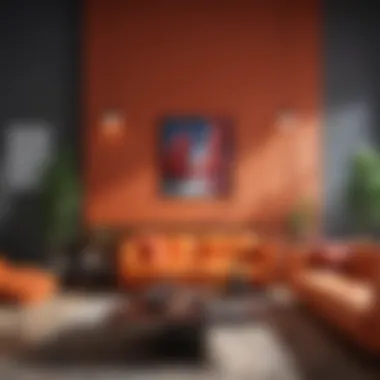
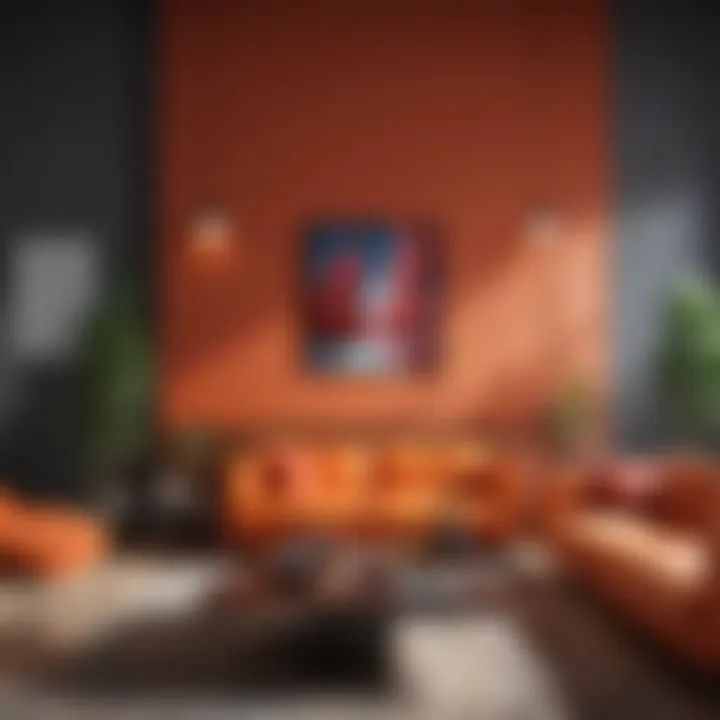
Intro
Interior wall colors play a vital role in design. They have the power to influence mood, enhance aesthetics, and manipulate the perception of space. Choosing the right color for a room is not merely an exercise in aesthetics. It requires understanding color theory, current trends, and practical applications. This guide aims to provide valuable insights for homeowners and design enthusiasts looking to create impactful environments through thoughtful color choices.
Interior Design Tips
Choosing colors for interior walls can feel overwhelming. However, certain strategies can simplify the process. Here are some key insights to keep in mind:
- Assess Lighting Conditions: Natural and artificial light affect how colors appear. Always test paint samples in different lighting. A color that seems perfect during the day may look entirely different at night.
- Understand Color Psychology: Different colors evoke distinct emotions. For instance, blue may create a serene environment, while yellow can foster warmth and optimism. Knowing how colors interact with emotions can guide your decisions.
- Consider Room Functionality: The purpose of a room is significant in color selection. For example, vibrant colors may energize a home office, while softer tones could promote relaxation in a bedroom.
- Plan as a Cohesive Palette: When selecting wall colors, think about the entire home. Each room should flow into the next. Therefore, creating a unified palette helps maintain harmony throughout different spaces.
Trendy Design Ideas
Current trends illustrate the power of wall color in modern homes. Here are a few:
- Earthy Tones: Colors such as terracotta and olive green are becoming popular. They promote a connection with nature, helping to create a relaxing atmosphere.
- Neutral Hues: Shades like beige and gray are timeless. They allow for easy accessorizing with other decor elements.
- Accent Walls: Using bold colors on one wall can add depth and intrigue without overwhelming the space.
Color Schemes and Combinations
Utilizing color schemes can enhance the overall effect of walls:
- Monochromatic: One color in various shades. It creates a sophisticated, clean look.
- Complementary: Opposite colors on the color wheel create contrast and vibrancy.
- Analogous: Colors next to each other on the wheel for a harmonious feel.
"A well-curated color palette can redefine the ambience of any living space."
Furniture Arrangement Techniques
The arrangement of furniture is crucial for optimizing space and enhancing color choices. Here are some practical tips:
- Anchor the Space: Use larger furniture pieces to establish a focal point that complements the wall color.
- Maintain Balance: Ensure that color intensity in furniture matches the wall tones. This prevents visual overpowering.
- Enhance Flow: Create clear pathways for movement. This allows colors to interact without clashing.
Closure
Incorporating strategic color selection into your interior design endeavors can vastly improve the feel and functionality of a space. Understanding the impact of color can lead to more informed choices, enhancing both the aesthetic and emotional quality of your home.
Prelims to Interior Wall Colors
The significance of wall colors in interior design cannot be overstated. They serve not only as a backdrop for our living spaces but also play a crucial role in shaping the overall mood and functionality of a room. When homeowners consider redecorating, the choice of color is usually one of the first decisions they make. This decision affects various aspects of home life, from aesthetic appeal to psychological impacts.
Choosing the right color can enhance the visual appeal of a space, evoke certain emotions, and even impact how we interact within that environment. A well-selected palette creates a cohesive look that can influence perceptions of space, making areas feel more inviting or even larger. Moreover, different colors can highlight unique architectural features or conceal less desirable elements.
In interior design, color is not just about personal preference; it's also about understanding its connection to style, trend, and environmental context. Being aware of these dynamics allows homeowners to create an atmosphere that reflects their personality and lifestyle. The study of color in interior design combines art with psychology.
Importance of Color in Interior Design
Color defines the essence of a room. Each hue carries its own weight of meaning and function. For instance, vibrant colors can inject energy and life into a space, while softer tones often evoke calmness and serenity. The atmosphere one wishes to create in a specific space dictates color selection. Moreover, understanding the fundamental role of color in design is imperative for effective planning.
- Aesthetic Appeal: A well-thought-out color infuses character to every room.
- Mood Regulation: Colors influence feelings. For example, blues and greens can promote relaxation.
- Spatial Perception: Lighter colors can make a room appear more spacious, while dark colors provide a cozy warmth.
Psychological Effects of Color
Beyond mere appearance, color has profound psychological implications. Studies in color psychology reveal:
- Red often boosts energy and evokes passion.
- Blue can induce feelings of calm and tranquility.
- Yellow is linked to happiness but can be overwhelming in excess.
- Green symbolizes nature and promotes a sense of balance.
A fundamental grasp of these effects aids homeowners and designers in selecting hues that will enhance the intended atmosphere of each space. An awareness of color preferences and their respective psychological effects helps shape environments conducive to specific activities.
"Understanding color is the first step towards creating spaces that resonate with the human experience."
This initial assessment of wall colors sets the stage for a deeper examination into color theory and practical applications, ensuring a comprehensive understanding of how wall colors contribute to home environments.
Understanding Color Theory
Color theory is a foundational aspect of interior design, playing a pivotal role in how wall colors influence a room. It goes beyond mere aesthetics and ventures into psychology, mood, and ambiance. Understanding color theory allows homeowners and enthusiasts to grasp how colors interact, evoke feelings, and shift perceptions. This understanding can lead to better choices that enhance living spaces.
Color theory provides a framework that categorizes colors, highlighting their relationships and implications. This helps in creating a harmonious environment that aligns with the intended purpose of each room.
The Color Wheel Explained
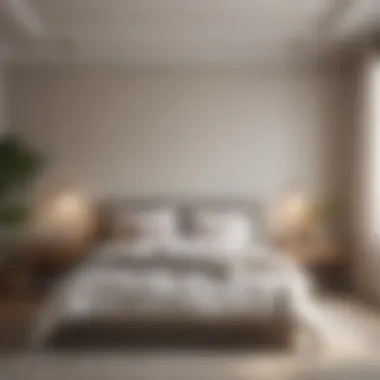
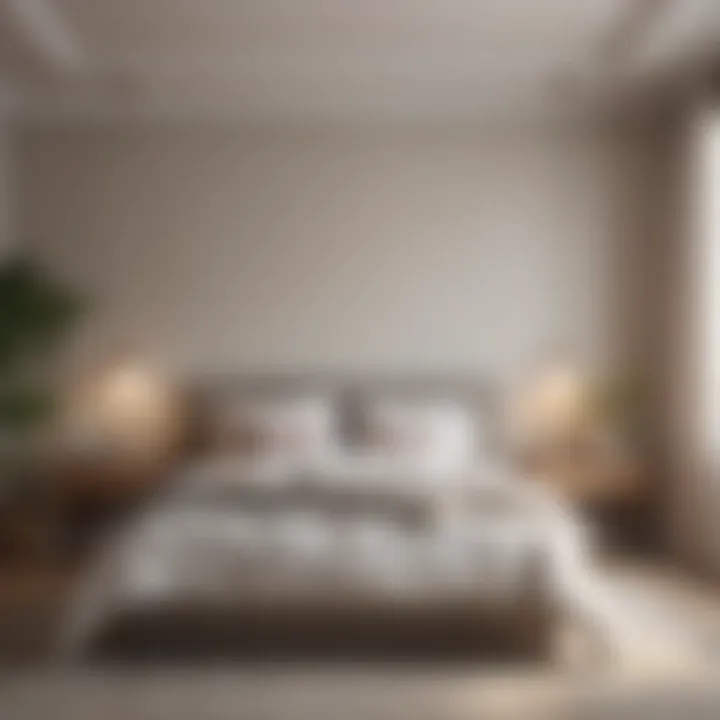
The color wheel is an essential tool in color theory. It visually represents colors arranged according to their chromatic relationship. The wheel is divided into primary, secondary, and tertiary colors. It is instrumental in selecting combinations that work well together. The primary colors are red, blue, and yellow, which cannot be made by mixing other colors. These colors serve as the foundation.
Secondary colors, which are green, orange, and purple, are achieved by combining primary colors. Tertiary colors come from mixing a primary color with a neighboring secondary color, resulting in hues like red-orange or blue-green.
These relationships can guide the selection of color palettes, ensuring coherence in design.
Primary, Secondary, and Tertiary Colors
In the context of interior design, understanding these three categories is vital. Primary colors can create bold statements when used prominently. For instance, a vibrant red accent wall can energize a living room.
Secondary colors soften the intensity while adding more depth and complexity. Incorporating these colors can balance the boldness of primary colors effectively. Tertiary colors, being a blend, can introduce subtlety.
Recognizing how to mix these colors can create a dynamic yet harmonious look throughout your home.
Warm and Cool Colors Described
Warm and cool colors significantly affect mood and perception of space. Warm colors, such as reds, yellows, and oranges, are stimulating and evoke warmth. They are often used to create inviting atmospheres, ideal for social areas like living rooms or kitchens.
By contrast, cool colors, including greens, blues, and purples, tend to have a calming effect. Cool colors can make a space feel more spacious and serene, making them well-suited for bedrooms and home offices.
In choosing the right mix of warm and cool colors, consider the room's purpose. A balance can lead to an inviting yet tranquil environment.
"The right color can transform not just a room, but the entire mood of your home."
Understanding these elements not only informs decision-making but also enriches the design experience, allowing for a personal touch that reflects style while enhancing comfort.
Choosing the Right Colors for Each Room
Selecting wall colors for different spaces is a critical component of effective interior design. Each room has its own function and energy, which can be enhanced or diminished through color choices. Understanding the psychological impact of colors, as well as how they interact with lighting and furnishings, can lead to a more harmonious living environment. Homeowners and design enthusiasts should consider the mood they wish to evoke and how colors can influence their daily experiences in each space.
Living Room Color Considerations
The living room is often seen as the heart of the home. It is typically where families gather and guests are entertained, so the choice of color can set the tone for social interactions. Warm colors like soft yellows, oranges, and reds can create a welcoming and cozy atmosphere. Alternatively, cool colors such as blues and greens may promote relaxation and calm, making them suitable for winding down after a long day.
When deciding on a living room color, consider the natural light available. Bright, well-lit spaces can handle darker tones without feeling oppressive. For those with limited natural light, lighter shades can help make the room feel larger and more inviting. Textured elements like cushions and curtains can also add richness and depth when combined with the wall color.
"Color is a power which directly influences the soul." – Wassily Kandinsky
Bedroom Color Selection Strategies
The bedroom is primarily a sanctuary for rest and relaxation. Therefore, the overall color scheme should foster a serene atmosphere. Soft pastels or muted shades typically work well here. Colors such as lavender, light blues, or pale greens are known to have calming effects, promoting better sleep and stressing less when entering the room.
One effective strategy is to follow a monochromatic scheme—selecting different shades of a single color. This can create a cohesive look while allowing for personalization in decor. Consider incorporating darker curtains or bedding to add contrast or using soft whites to accentuate the primary color for a lighter feel.
Kitchen and Dining Room Colors
In kitchens, colors should promote energy and cheerfulness. Bright whites and airy shades can enhance the feeling of cleanliness, while lively colors such as yellows or reds can stimulate appetite and conversation. On the other hand, earthy tones like terracotta or deep greens can evoke warmth and comfort, making dining areas feel more inviting.
It’s also important to consider surface materials and appliances. A modern stainless-steel fridge may contrast with rich, dark wallpaper. To create a balanced look, make sure to select paint colors that complement or match your existing furnishing and fixtures.
Utilizing Color in Home Offices
With more people working from home, the home office has gained importance. The color choices in this space can directly affect productivity and focus. Neutral colors such as beige or gray are good choices to create a calm and efficient environment, while vibrant accents like a bold blue or green can spark creativity.
Incorporating an accent wall can introduce an energizing hue without overwhelming the entire space. Additionally, pay attention to the work surface. A desk with warm wood tones may look best against cooler wall colors, creating a sense of balance.
Popular Color Palettes in Interior Design
Color palettes play a crucial role in interior design. They offer structure and intent to a space, creating specific moods and enhancing the aesthetic appeal. Understanding different palettes allows homeowners and designers to make informed decisions that resonate with the intended atmosphere of the room.
In this section, we will explore various popular color palettes, each with unique characteristics and applications. By appreciating these palettes, one can effectively coordinate colors throughout their home, ensuring harmony and consistency in design.
Monochromatic Schemes
Monochromatic color schemes utilize variations of a single color, incorporating different shades, tints, and tones. This approach can create a serene and cohesive look. It’s particularly effective in smaller spaces, where it can help make the area feel more expansive. The beauty of monochromatic palettes lies in their simplicity and sophistication.
For example, a room painted in soft blue can have a mix of lighter and darker blues in its furniture and accents. This method keeps the design polished while still allowing for individual creativity. However, it’s essential to introduce textures and patterns to avoid monotony.
Complementary Colors
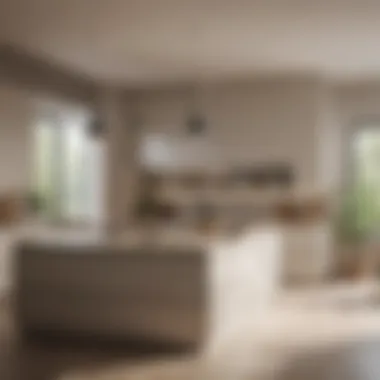
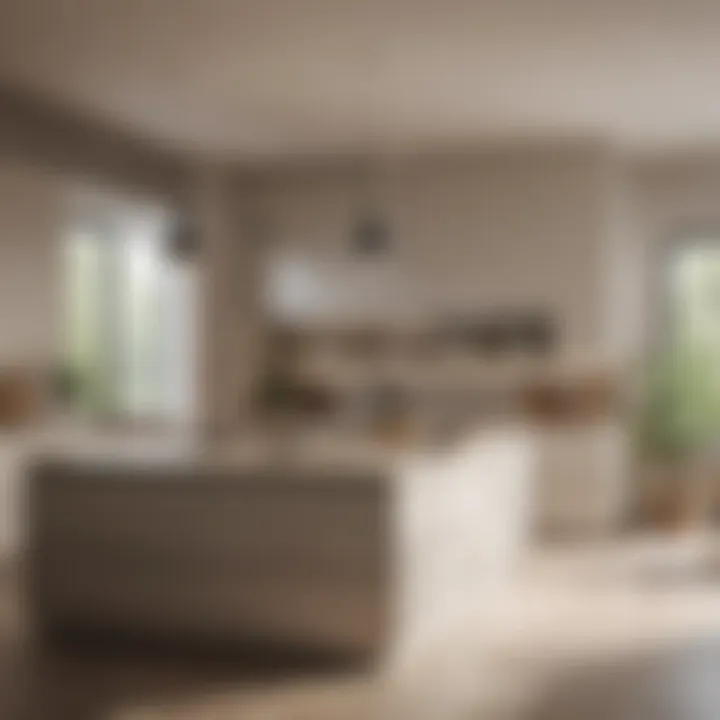
Complementary color schemes involve pairing colors that sit opposite each other on the color wheel. This creates a vibrant contrast that can energize a space. For instance, a combination of blue and orange can make a living room feel dynamic and engaging.
Using complementary colors can draw attention to specific areas. However, balance is key. Too many contrasting colors might create a chaotic atmosphere. Select one dominant color and use its complementary for smaller accents to maintain harmony.
Analogous Color Schemes
Analogous color schemes consist of three colors that are next to each other on the color wheel. This palette type promotes harmony and is naturally pleasing to the eye. It works well in different spaces, whether in a cozy bedroom with greens, yellows, and soft oranges or a calm living room with blues, teals, and greens.
The strength of analogous palettes is in their subtlety. They create a peaceful ambiance, making them ideal for relaxation areas. To add depth, consider varying the intensity of these colors within the room.
Neutral Color Combinations
Neutral color combinations focus on soft, understated hues such as grays, beiges, whites, and browns. These palettes are versatile and easy to pair with more vibrant colors or patterns. Neutrals serve as a perfect backdrop, allowing other elements in the room to shine.
Using neutral tones can help simplify a design. For instance, a neutral living room can act as a canvas for colorful furniture or artwork. This approach works seamlessly across multiple styles, from modern to farmhouse. Additionally, incorporating natural materials can enhance the neutrality while adding warmth.
"Choosing the right color palette sets the foundation for an inviting and balanced interior design."
Embracing popular color palettes not only transforms a room but also reflects personal tastes and harmonizes with existing decor. By understanding these foundational elements, one can create engaging environments that speak to both function and style.
Factors Influencing Color Choice
Choosing the right wall color for a space goes beyond personal preference. There are several practical factors to consider that come together to create a harmonious environment. Understanding these elements enhances the overall aesthetic and functionality of the space. Making informed decisions based on these factors can greatly improve the atmosphere of a home.
Lighting Conditions
Lighting plays a pivotal role in how wall colors are perceived. Natural light can change the appearance of colors throughout the day. For example, a soft beige may look warm and inviting in the morning sun, but could appear cooler in dim light. Additionally, artificial lighting can also impact color perception. Fluorescent lights tend to bring out cool tones, while incandescent bulbs emphasize warmer shades.
Consider these tips when evaluating lighting conditions:
- Natural Light: Observe how your chosen colors appear at different times of the day.
- Artificial Light Source: Test colors under your room's primary light source to ensure they maintain their desired look.
- Direction of Light: South-facing rooms receive more sunlight, while north-facing rooms have cooler, subdued light.
Room Function and Size
Different rooms serve different purposes, which can dictate their color schemes. For instance, a home office may benefit from calming blues to promote focus, whereas a dining room might thrive with warmer tones to create a welcoming atmosphere. The size of the room also influences color choice. Lighter shades can make a small room feel larger, while darker colors may add coziness to spacious areas.
Here are a few considerations regarding room function and size:
- Purpose of the Room: Think about what activities will take place there and select colors that enhance those vibes.
- Room Size: Use lighter shades in cramped spaces and richer tones in larger rooms for warmth.
Existing Furnishings and Decor
The color of walls should complement existing furnishings and decor to create a cohesive look. This involves evaluating the pieces you already have in a room, such as:
- Furniture Colors: Is your furniture dark or light? Selecting wall colors that contrast or harmonize can greatly affect the overall ambiance.
- Art and Decor: If there are standout items, like paintings or decorative accents, the wall color should either highlight them or provide a subtle contrast.
- Flooring: The existing floor color can influence how wall colors look. Lighter floors with darker walls or vice-versa can create balance.
Remember, the aim is to create an environment that feels unified and intentional.
Considering these factors thoughtfully can lead to a more integrated design approach. It is essential to remember that each element plays a role in how colors work together within a space, allowing homeowners to make choices that resonate well with their unique style.
Trends in Interior Wall Colors
The ever-evolving trends in interior wall colors hold significant relevance in contemporary design. They reflect not just aesthetic preferences but also cultural shifts and lifestyle changes. Understanding these trends can enhance a homeowner's ability to create appealing environments. It allows one to stay aligned with current tastes while still making personalized choices. Practical applications of the latest color trends contribute to a vivid, sophisticated interior that speaks to the values and priorities of the inhabitants.
Current Popular Colors
As of 2023, certain colors have emerged as favorites among homeowners and designers alike. These colors bring life and character to spaces, ensuring a cohesive look in modern homes.
- Soft Neutrals: Shades like greige and taupe continue to dominate. They offer versatility, serving as a perfect backdrop for any decor. Soft neutrals enhance natural light and create a calming atmosphere.
- Earthy Tones: Colors such as terracotta, olive green, and warm browns reflect a growing inclination towards nature. These hues ground spaces, adding warmth and coziness.
- Bold Accent Colors: Colors like deep blue and hunter green are increasingly being used as accents. They add dramatic flair and can highlight certain areas or features within a room.
These popular colors not only satisfy aesthetic criteria but also cater to psychological needs for comfort and connection to nature.
Emerging Color Trends
In addition to the established preferences, new trends are emerging on the horizon. These colors often capture the essence of modern living, focusing on sustainability and emotional wellness.
- Muted Pastels: Soft pastels such as pale pink and dusty lavender have started to trend. These colors promote a sense of tranquility and openness. They provide a great way to create a soft, inviting ambiance without overwhelming the senses.
- Biophilic Hues: Inspired by nature, shades taken directly from the environment are gaining traction. Colors like forest green and sky blue are being embraced for their calming effects and connection to the outdoors.
- Vibrant Jewel Tones: Colors such as emerald green and sapphire blue are making a comeback, appealing to those wanting to make bolder choices. These vibrant shades can energize a space and create striking focal points that demand attention.
As homeowners gain more awareness of their surroundings, the choices in wall colors reflect a more profound understanding of the impact on mood and well-being. Keeping abreast of these trends helps in making informed and forward-thinking decisions in interior design.
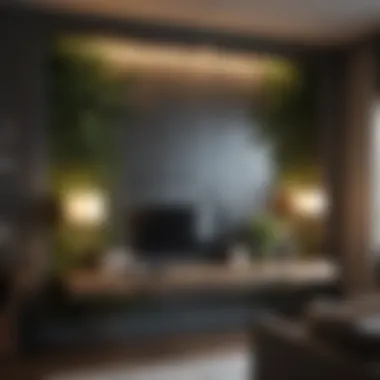
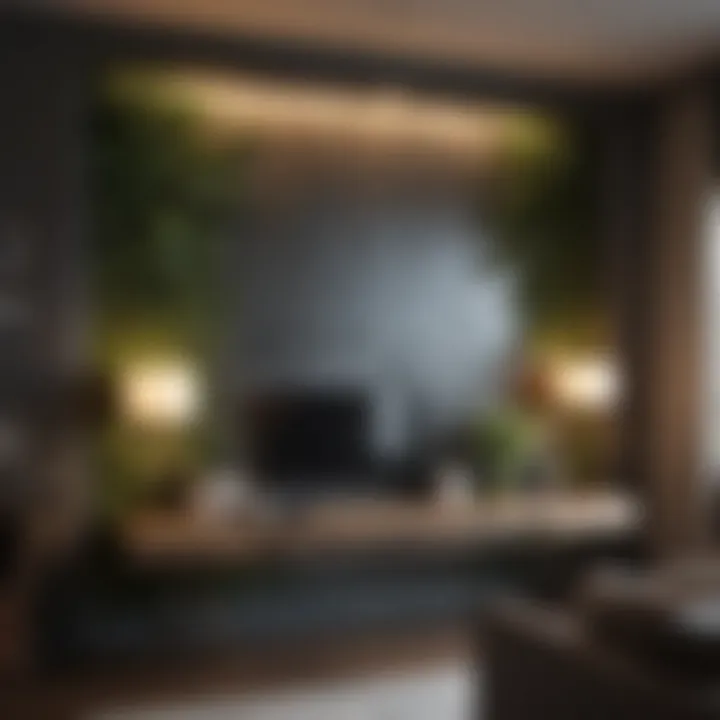
Techniques for Applying Wall Colors
Understanding the techniques for applying wall colors is essential in any interior design project. The approach taken not only affects the outcome visually but can also influence the longevity of the finish and the overall feel of the space. Selecting the right method can maximize both the aesthetic appeal and functional aspects of wall colors in your home. Whether you favor simplicity or complex designs, the techniques employed can elevate the spaces you inhabit.
Painting vs. Wallpapering
When choosing between painting and wallpapering, several factors come into consideration. Painting offers flexibility and ease, allowing for quick updates with minimal cost. It's also ideal for creating a smooth finish that can suit various styles, from modern to traditional. Color can be changed easily, making it a great option for those who like to refresh their environment often.
Conversely, wallpapering introduces patterns and textures that paint cannot achieve alone. It can be particularly effective in adding depth and personality to a room. Modern wallpaper options are often designed for easy application and removal, reducing the stress associated with pasting paper on walls.
Some benefits and considerations for each method are:
- Painting:
- Wallpapering:
- Quick application and touch-ups
- Wide variety of colors available
- Easier to change in future
- Requires preparation and cleanup
- Offers unique patterns and textures
- Can add warmth and character
- Longer-lasting finish if well-maintained
- May require professional installation for best results
Deciding between these two techniques ultimately depends on your personal preference and the overall vision you have for your space.
Accent Walls: A Focused Approach
Accent walls present an exciting opportunity for creative expression in interior design. By selecting a single wall to feature a bold color or unique pattern, one can create a focal point that draws attention without overwhelming the room. This approach can add depth and interest, making a space feel more dynamic.
The benefits of implementing an accent wall include:
- Enhanced Visual Interest: A strong color or pattern can serve as an engaging backdrop for artwork or furniture.
- Defining Spaces: It helps in demarcating spaces within an open floor plan, providing a sense of individuality to different areas.
- Easier Changes: Updating an accent wall is less daunting than repainting or re-wallpapering an entire room.
When choosing color or design for your accent wall, consider these points:
- Choose a color that corroborates with the existing palette in the room.
- Opt for a pattern that resonates with your style preferences.
- Ensure the wall you select receives adequate natural light to facilitate the color’s vibrancy.
An effective accent wall can serve as a conversation piece and enhance the overall appeal of your living space.
Harmonizing Colors Throughout Your Home
Creating a cohesive look within your home requires thoughtful consideration of wall colors. This section focuses on the importance of harmonizing colors throughout your space. When colors flow seamlessly from one area to another, the overall aesthetic improves. This not only enhances visual appeal but also creates a sense of unity and calmness in your surroundings. A well-balanced color scheme can transform an ordinary room into a cohesive living area.
One significant benefit of harmonizing colors is that it can help define different areas within an open space. For instance, using complementary colors in adjacent rooms can create a visually appealing transition, guiding the eye naturally from one space to another. Additionally, harmonized colors can emphasize the architecture of your home, drawing attention away from imperfections and highlighting features you want to showcase.
Considerations like natural light and the purpose of each room, play critical roles in this process. The right palette not only enhances the look but also supports the functionality of a space. By strategically choosing colors and ensuring they work together, you will develop an environment that feels both welcoming and purposeful.
Creating Flow Between Spaces
Establishing a flow between spaces requires careful planning. Select colors that connect visually while also accounting for light and size. Often, lighter shades will enhance the perception of space. Conversely, darker shades may help intimate areas feel warmer and more enclosed.
- Choose a base color: This will serve as the foundation for your entire home. It can be a neutral tone or a soft hue that many can appreciate.
- Use accents effectively: Accent colors can be applied to furniture, artwork, or decorative pieces to tie different spaces together.
- Transition appropriately: When moving from one room to another, consider slightly altering the color shade while keeping the essence. For example, if a living room is blue, a lighter or darker blue can work in the nearby hallway.
Maintaining this flow is crucial for fostering an inviting atmosphere.
Balancing Bold and Subtle Colors
Striking a balance between bold and subtle colors is essential for well-rounded interior design. Bold colors can energize a space and express personality, yet too much can be overwhelming. On the other hand, subtle colors create calmness and elegance but may lack vibrancy.
To achieve balance:
- Accent wisely: Use bold colors for accent walls or furniture pieces to create focal points without overwhelming the room.
- Layer patterns: If you use bold colors, consider pairing them with neutral or soft patterns to maintain a visually engaging yet harmonious environment.
- Evaluate proportions: Assess how much space a color occupies. Larger areas in bold colors may be visually heavy, so keep this in mind during selection.
Ultimately, a well-executed blend of bold and subtle colors results in spaces that feel both lively and serene. A carefully curated color scheme can lead to a sophisticated home that reflects individual style and provides comfort.
End: Making Informed Color Choices
Making informed color choices is essential in creating spaces that reflect individuality and work well for daily living. The decision of which color to paint interior walls impacts the overall atmosphere of a room. Colors can transform a simple area into a sanctuary or a vibrant gathering place. Recognizing this influence is the first step toward improving personal satisfaction within a home environment.
Reflecting Personal Style
Choosing wall colors allows homeowners to express their unique style and personality. This process is about more than merely selecting a favorite shade. It involves understanding how colors can complement existing decor and furniture while still maintaining cohesion in a home. Consideration should be given to the synergy of colors. A choice like soft pastels can bring serenity, while bold, vivid hues can offer stimulation. Homeowners might also explore combining colors to add depth.
Reflecting personal style through color choices means assessing how the rest of the home feels. Is there a contemporary theme? Does the space feel eclectic or traditional? Aligning wall colors with personal tastes can result in a more harmonious living experience. Key to this reflection is ensuring the final palette not only embodies style but also contributes positively to mood and comfort.
Future of Interior Wall Colors
The future of interior wall colors continues to evolve with societal trends, technology, and individual preferences. New materials and paint technologies are making it easier to achieve desired effects. Innovations include eco-friendly paints and products that enhance durability. Such advancements allow for flexibility in approach and experimentation.
As design trends shift, homeowners might see a rise in colors that were once deemed unconventional. Deeper, richer tones and even unexpected shades are gaining traction. Furthermore, the concept of flexibility in design is growing. Functional spaces are increasingly incorporating colors that suit various purposes throughout the day.







